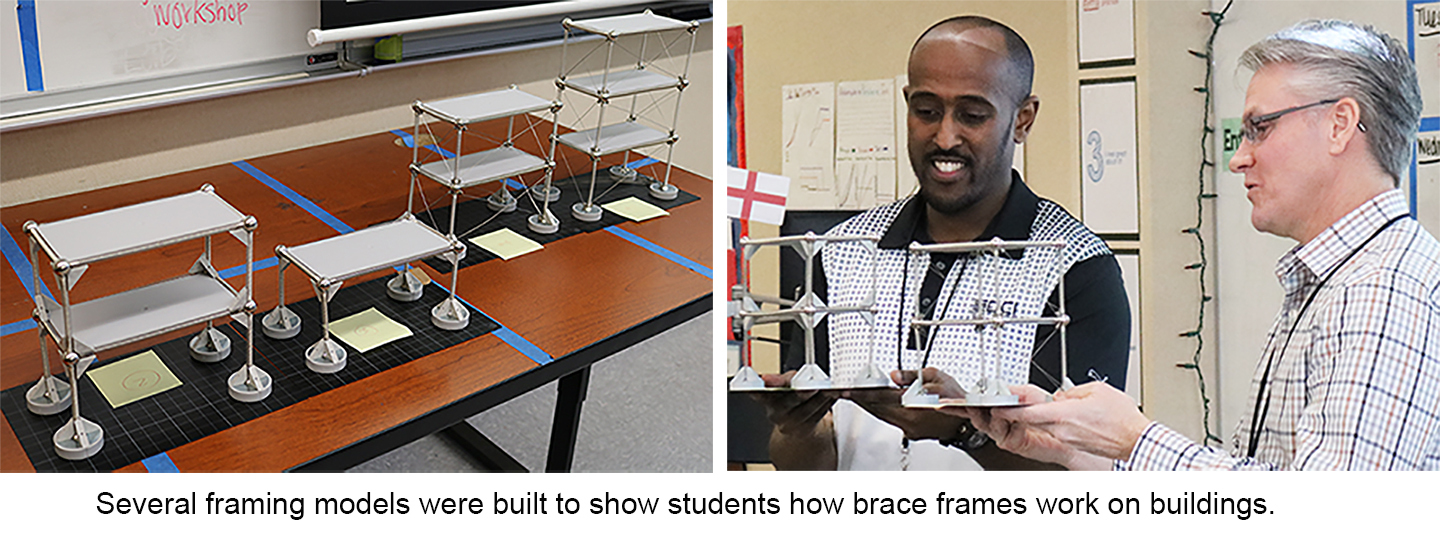In the spirit of National Engineers Week, we’re sharing a recent experience when visiting a local school to meet students learning advanced sciences.
DCI Engineers and Landau Associates were guest speakers at Hamilton International Middle School to discuss everyday engineering activities they do at the office or in the field. The students learned how data collected from geotechnical engineers’ soil reports inform structural engineers on how to design a building for a specific site.

Landau Associates Principal Engineer Steve Wright described how geotechnical engineers routinely collect dirt or cores from a property site (sometimes even repelling off of cliffs to extract samples) to determine the condition of the soil. After running soil tests in their laboratory, they generate reports for their clients, who can be structural engineers, developers, architects, and so on.

The geotechnical engineers explained how air pockets are commonly found in gravel and different types of soil, such as sand, silt, or clay. Shifts can happen in the soil depending on the type of dirt, amount of movement in the earth, and environmental conditions. The air pockets can then move or escape from the soil, which can alter the conditions of the ground surface and sub-surfaces.

Daniel Simpson, a Project Engineer from Landau Associates, demonstrated shifts in soil with a pan of dirt mixed with water. He buried a ping pong ball and steel tube into the mixture and hammered the side of the pan simulating an earthquake. The students observed the ping pong ball surface from the dirt, while the steel tube tilted from its original position as air pockets and water released from the mixture caused the soil to shift. Geotechnical engineers call this soil condition during earthquakes the liquefaction of soil. Liquefaction of the soil can cause manhole tunnels to surface above paved concrete or ruin a building foundation.
DCI’s Principal Engineer Grant Buckingham mentioned the common practice of designing underground piers for a building is to stabilize the building on soft soil. One of the students asked if digging out all the soft soil below the building would be a solution, and Grant confirmed excavating soft soil until you reached bedrock would be a plausible fix, but expensive. He mentioned a big part of managing a successful project is accommodating to the client’s budget and finding alternative structural answers on a case by case basis.
He also mentioned the structural importance of a building’s ductility. Seismologists, scientists, and engineers gained important knowledge after the 1994 Northridge Earthquake – structural engineers learned to design buildings more appropriately for ductility.
Students were given pipe cleaners and slender wooden sticks to differentiate between materials with more give than the other. When a building does not have much ductility, there is more possibility for columns and building facades to break – such as an unreinforced brick structure. The class was also given wooden rulers to apply pressure on the widest and thinnest sides. This tangible demonstration exhibited the concepts of deflection and stiffness, which are commonly calculated for the strength of columns and components of framing systems. The greater the depth of a rectangle-shaped object, the stiffer it becomes (according to the equation I = bd³/12).


DCI’s Project Engineer Alex Mengistu and Grant also demonstrated basic concepts of structural framing with Mola Structural Kit models and shaking the foundation base, simulating an earthquake. The students asked questions, such as the effect of brace frame placement and different building material ductililty. To demonstrate motion frequency, Grant gently shook the base of a wooden model with three towers of different heights. A more intense frequency caused the lower tower to sway, while a moderate frequency caused the medium height building to sway. A student asked about installing a balancing mechanism to the tower to lessen the sway. Grant was pleased to say there are water tank dampening systems you can place on the top level of a high-rise to do exactly that.
Smart kids asking the right questions, such as “is engineering fun?” Daniel Simpson said he enjoys his job because he gets to be outdoors. Grant chimed in saying that when you are an engineer, you won’t always be at your desk. You will be speaking to clients on a construction site to see the project being built.
Since the kids we met were all about the action, we’ve got a good feeling about the next generation of geotechnical and structural engineers!
Rose Bechtold, Communications Specialist | Rose comes from a journalism and technical writing background. She is in her element while in research mode and naturally immerses herself in expert knowledge by interviewing staff members about new subjects. In her spare time, Rose practices plein-air sketching of buildings and random scenes around town.